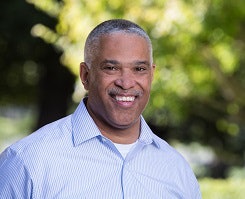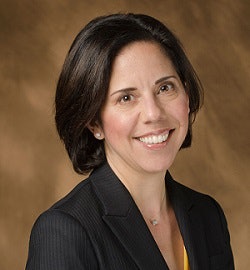Providing early research experiences and creating supportive campus environments are among the promising and intentional strategies outlined in a new report from the National Academies of Sciences, Engineering and Medicine focused on the impact and role of minority-serving institutions (MSIs) in producing graduates in science, technology, engineering and mathematics (STEM).
 Dr. Kent McGuire
Dr. Kent McGuireThe academy’s report “Minority-Serving Institutions: America’s Underutilized Resource for Strengthening the STEM Workforce” reaffirms the relevance of MSIs and notes an urgent need to invest in the institutions to not only graduate and prepare MSI students for in-demand STEM careers, but also to sustain and enhance the nation’s economic prosperity, global competitiveness and national security, according to committee members sponsoring the report.
“This country can’t strengthen the STEM pipeline and bring more people into it without engaging the institutions where the students actually are,” said Dr. Kent McGuire, co-chair of the Committee on Closing the Equity Gap: Securing Our STEM Education and Workforce Readiness Infrastructure in the Nation’s Minority-Serving Institutions. “The conversation isn’t about, ‘Well, we can’t work with these schools because they don’t have this or they don’t have that.’ The conversation has to be, ‘We won’t actually be competitive internationally if we don’t help these schools do well what it is they do.’”
McGuire, who is also program director of education at the William and Flora Hewlett Foundation, added that, among other things, the report speaks to the variation among MSIs in how they serve students and also the challenges they face collectively and individually. America’s nearly 700 two- and four-year MSIs include historically Black colleges and universities (HBCUs), Tribal colleges and universities (TCUs), Hispanic-serving institutions (HSIs) and Asian American and Native American Pacific Islander-Serving Institutions (AANAPISIs).
“There’s a lot of misunderstanding or lack of understanding from many different stakeholders that we’re trying to reach with this report including policymakers, including institutional leadership, including individuals at the state level,” said Dr. Lorelle Espinosa, co-chair of the committee and vice president for research at the American Council on Education. “We’re trying to speak to a number of different stakeholders about the importance and the relevance and the need to pay strict attention to the MSI sector in terms of investment.”
MSIs currently educate roughly 30 percent of U.S. undergraduates, the report said, and produce one-fifth of the country’s STEM bachelor’s degrees. HBCUs, particularly, produce more African-American graduates in STEM than all Ivy League institutions combined.
Seven evidence-based recommendations for strengthening MSIs’ capacity to provide quality STEM education and workforce preparation for their students emerged from the committee’s analysis of available research and literature, site visits to nine MSIs and from public forums with institutional leaders, program and department heads, faculty, students and other stakeholders.
The “promising” strategies included:
-Having dynamic, multilevel, mission-driven leaders;
-Building institutional responsiveness to meet students where they are;
-Creating supportive campus environments that build a sense of community and “equity-oriented” culture;
-Offering tailored, intentional and holistic academic and social supports;
-Providing mentorship and sponsorship;
-Introducing students to undergraduate research experiences early on; and
-Establishing mutually beneficial public-private sector partnerships.
Arizona State University, an HSI, for example, articulated its “intentional embrace” of creating a welcoming and nurturing environment through its charter in 2014.
The charter reads: “ASU is a comprehensive public research university, measured not by whom it excludes, but by whom it includes and how they succeed; advancing research and discovery of public value; and assuming fundamental responsibility for the economic, social, cultural and overall health of the communities it serves.”
The Alaska Native Science and Engineering Program (ANSEP) at the University of Alaska-Anchorage similarly embodies the strategies in the report by targeting students earlier in the pipeline – as early as sixth grade – and supporting and nurturing their intellectual growth and interest in STEM fields as they matriculate through their postsecondary education. ANSEP additionally offers a summer bridge program and “success” programs that address the academic and cultural needs of undergraduate and graduate students.
Espinosa said that the strategies listed in the report are ones that researchers know benefit students in all environments.
 Dr. Lorelle L. Espinosa
Dr. Lorelle L. Espinosa“But the difference is that at MSIs, we have observed a different level of intentionality by which [the] institutions – their leadership, their faculty, their staff … just the way that they approach meeting the needs of students – has a different feel to it in terms of that intentionality,” she said, adding that many MSIs approach serving their students in a “more hands-on way that sets high expectations but also provides needed support and mentoring and guidance.”
“Some of this stuff doesn’t cost money; it’s about the culture,” Espinosa added.
The recommendations also provide an opportunity for emerging MSIs to become intentional about how they expect to serve students using the promising practices, Espinosa said.
“At the same time, we think there’s more the government can do, particularly the federal government, to make their existing competitive opportunities and grant programs more transparent for these schools and [to give] them a stronger shot at competing effectively for the resources that are out there,” McGuire said.
The report points out that because many MSIs lack the resources or infrastructure to be as competitive as predominantly White institutions, the government, philanthropic organizations and other industry sectors or educational institutions can better equip MSIs to have the capacity to tackle the complex grant-writing process or “go after contracts that require a lot of relationship management and have a certain level of bureaucracy that a well-resourced institution can meet,” Espinosa said.
Similarly, ensuring that public-private partnerships are mutually beneficial is a priority, as these collaborations can provide additional funding and educational and research opportunities for students, the report said.
“One of the things that is clear, not just from the literature about STEM efforts in MSIs, but more broadly, is that in fields where research and inquiry is a part of what you need to know how to do, the sooner students have access to those opportunities, the sooner they know for sure what majors, what career opportunities they want to pursue,” McGuire said. “The sooner they develop relationships with faculty and other researchers, the sooner they have an understanding of what success looks like and the level of energy and engagement they will have to bring to the table.”
The co-chairs believe intentionality on the part of educational leaders, policymakers and the private sector combined with implementation of the promising strategies at MSIs will “go a long way” in closing the equity gap, specifically in the STEM discipline.
“We can’t solve our problem or meet our challenge, at least not anymore, by importing talent from around the world,” McGuire said. “We really have to do it here at home.”
Tiffany Pennamon can be reached at [email protected]. You can follow her on Twitter @tiffanypennamon.


















